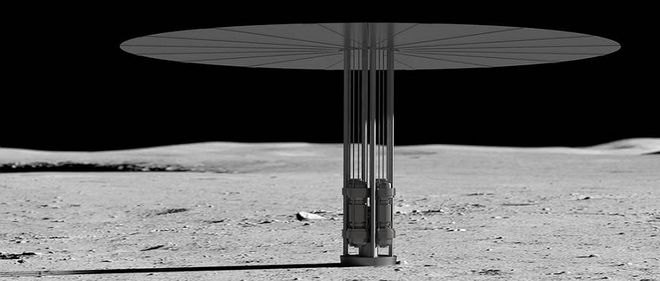The National Aeronautics and Space Administration (NASA) and the U.S. Department of Energy (DOE) announced on June 21, local time, that they are jointly advancing space nuclear technology and have planned the nuclear fission surface energy project (The Fission Surface Power project) for them. Three design concept proposals were selected.
The design proposals came from US aerospace companies Lockheed Martin Space Systems, electrical companies Westinghouse and IX. IX is a joint venture between autonomous driving systems company Intuitive Machines and nuclear reactor designer X-Energy. The three companies will each receive a 12-month contract worth $5 million (about 33.5075 million yuan).
1. Go to the moon to build a “nuclear power plant” at the end of this century
NASA and the DOE are exploring space nuclear technology because electricity is not readily available on the moon or beyond. When astronauts get to the moon and then to Mars, they need a reliable and portable power system. The power system should also be able to operate in different places and in different environmental and weather conditions. Nuclear fission power generation systems meet these criteria.
▲Conceptual map of nuclear fission surface energy system
By the end of the century, NASA and the DOE hope to test a 40-kilowatt-class nuclear fission power system on the moon. Such nuclear power systems tested on the moon will pave the way for long-term human missions to the moon and Mars.
“The nuclear fission surface energy project is a practical first step toward building a nuclear power plant on the moon for the United States,” John Wagner, director of the U.S. Department of Energy’s Idaho National Laboratory, said in a statement.
2. 3 space nuclear power project contracts, 8 companies participated
DOE’s Idaho National Laboratory is responsible for the contract award for the project. The three contracts for nuclear fission surface energy project design concept proposals totaling about $15 million (about 100 million yuan) are used to support the development of preliminary design concepts for a 40-kilowatt nuclear fission power system. The project requires the design of a nuclear fission power system that can work on the moon for at least 10 years.
Lockheed Martin Space Systems in Bethesda, Maryland, Westinghouse Electric in Cranberry, Pennsylvania, and IX in Houston, Texas each won a contract for the project.
Lockheed Martin Space Systems will work with BWXT, a nuclear fuel supplier for nuclear components, and Creare, an engineering research and development provider, to complete the project.
Westinghouse will partner with aerospace company Aerojet Rocketdyne to develop the project.
IX is working with aerospace technology companies Maxar and Boeing to advance the project.
3. NASA has tested the space nuclear reactor project
Before the nuclear fission surface energy project, NASA had promoted the KiloPower project, another space nuclear power project. In 2015, NASA officially launched the KiloPower project, a new generation of space nuclear reactors. In May 2018, the project completed all major surface tests.
A few years later, in 2021, NASA and DOE collaborated on a request for comments asking U.S. companies to provide design concepts for nuclear fission surface energy systems.
Conclusion: Aerospace powers all deploy aerospace nuclear energy research
From the information given by NASA, the United States continues to promote the use of nuclear energy in space exploration.
China, Russia and other aerospace powers have also begun to explore the application of nuclear energy in the aerospace field. For example, Russia’s “development plan for the next ten years” submitted in 2016 mentioned the construction of nuclear-powered engine prototypes to support spacecraft in deep space exploration. In an interview, the deputy director of China’s National Atomic Energy Agency clearly pointed out that my country’s deep space exploration will use nuclear energy in the future.




GIPHY App Key not set. Please check settings